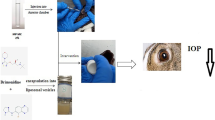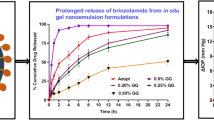Abstract
In this study, nanovesicles were developed for brimonidine tartrate by film hydration technique and dispersed in viscous carbopol solution for ocular delivery. Scanning electron microscopy revealed spherical shape of the vesicles. As high as 32.27% drug entrapment efficiency was achieved depending upon the surfactant/cholesterol molar ratio (7:4 to 7:8). The vesicles were in the size range of 298.0–587.9 nm. Release study showed a biphasic drug-release pattern for the lyophilized vesicular formulation in buffered saline solution, i.e., initial burst release followed by gradual release over the period of 8 h. On contrary, the isolated vesicles reduced the burst effect in 3 h by two to three times and the drug release was comparatively slower at the intermediate ratio in both cases. With variation in cholesterol content, the drug release followed either first order or Higuchi’s kinetics. Physically the lyophilized vesicular formulations were more stable at refrigerated temperature. DSC and X-RD analyses indicated loss of drug crystallinity in the vesicles. FTIR spectroscopy did not reveal any interaction between drug and excipients. The lyophilized formulation showed better ocular hypotensive activity than marketed drops on albino rabbits and in vivo efficacy was sustained up to 7.5 h. Furthermore, the formulation was found to be non-irritant to the rabbit eye. Hence, the lyophilized vesicles, when dispersed in viscous carbopol solution, had the potential in reducing dosing frequency and could improve patient compliance.







Similar content being viewed by others
REFERENCES
Chiang C-H. Ocular drug delivery systems of antiglaucoma agents. J Med Sci. 1991;12:157–70.
Thylefors B, Négrel AD. The global impact of glaucoma. Bull World Health Org. 1994;72:323–6.
Pisella PJ, Pouliquen P, Baudouin C. Prevalence of ocular symptoms and signs with preserved and preservative free glaucoma medication. Br J Ophthalmol. 2002;86:418–23.
Baffa LP, Ricardo JR, Dias AC, Módulo CM, Braz AM, Paula JS, et al. Tear film and ocular surface alterations in chronic users of anti-glaucoma medications. Arq Bras Oftalmol. 2008;71:18–21.
Kaur IP, Garg A, Singla AK, Aggarwal D. Vesicular systems in ocular drug delivery: an overview. Int J Pharm. 2004;269:1–14.
Sanzgiri YD, Mashi S, Crescenzi V, Callegaro L, Topp EM, Stella VJ. Gellan-based systems for ophthalmic sustained delivery of methylprednisolone. J Control Rel. 1993;26:195–201.
Zignani M, Tabatabay C, Gurny R. Topical semi-solid drug delivery: kinetics and tolerance of ophthalmic hydrogels. Adv Drug Deliv Rev. 1995;16:51–60.
Urtti A. Ocular drug delivery. Adv Drug Deliv Rev. 2006;58:1129–30.
Saettone MF, Giannaccini B, Chetoni P, Torracca MT, Monti D. Evaluation of high- and low-molecular-weight fractions of sodium hyaluronate and an ionic complex as adjuvants for topical ophthalmic vehicles containing pilocarpine. Int J Pharm. 1991;72:131–9.
Kumar S, Haglund BO, Himmelstein KJ. In situ-forming gels for ophthalmic drug delivery. J Ocular Pharmacol. 1994;10:47–56.
Patel D, Patel MM, Patel NM, Patel M. Preparation and evaluation of ocular insert containing brimonidine tratrate. Int J Pharm Clin Res. 2009;1:19–22.
Chan J, El Maghraby GMM, Craig JP, Alany RG. Ocular delivery of pilocarpine hydrochloride from phase transition microemulsions: in vitro in vivo evaluation. Int J Pharm. 2007;328:65–71.
Jain SP, Shah SP, Rajadhyaksha NS, Pal Singh PSP, Amin PD. In situ ophthalmic gel of ciprofloxacin hydrochloride for once a day sustained delivery. Drug Dev Ind Pharm. 2008;34:445–52.
Patel GM, Patel MM. Recent advances and challenges in ocular drug delivery system. Pharma Times. 2007;39:21–5.
Agnihotri SA, Aminabhavi TM. Chitosan nanoparticles for prolonged delivery of timolol maleate. Drug Dev Ind Pharm. 2007;33:1254–62.
Nagarsenkar MS, Londhe VY, Nadkarni GD. Preparation and evaluation of liposomal formulations of tropicamide for ocular delivery. Int J Pharm. 1999;190:63–71.
Saettone MF, Perini G, Carafa M, Santucci E, Alhaique F. Non-ionic surfactant vesicles as ophthalmic carriers for cyclopentolate a preliminary evaluation. STP Pharm Sci. 1996;94:98.
Moroi SE, Lichter PR. Ocular pharmacology. In: Brunton LL, Lazo JS, Parker KL, editors. Goodman & Gilman’s: the pharmacological basis of therapeutics. New York: The McGraw Hill; 2001. p. 1821–48.
Abraham S, Furtado S, Bharath S, Basavaraj BV, Deveswaran R, Madhavan V. Sustained ophthalmic delivery of ofloxacin from an ion-activated in situ gelling system. Pak J Pharm Sci. 2009;22:175–9.
Mukherjee B, Patra B, Layek B, Mukherjee A. Sustained release of acyclovir from nano-liposomes and nano-niosomes: an in vitro study. Int J Nanomedicine. 2007;2:213–25.
Uchegbu IF, Florence AT. Nonionic surfactant vesicles (niosomes)—physical and pharmaceutical chemistry. Adv Colloid Interf Sci. 1995;58:1–55.
McKinnon SJ, Goldberg LD, Peeples P, Walt JG, Bramley TG. Current management of glaucoma and the need for complete therapy. Am J Manag Care. 2008;14:S20–7.
Chang JN, Spada LP, Blanda WM, Orilla WC, Bruke JA, Hughes PM. Alpha-2-agonist-polymeric-drug-delivery-systems. US Patent Application 20060233860, 2006.
Kamath AP, Satyanarayana S, Rodrigues CFEA. Ocular surface changes in primary open angle glaucoma with long term topical antiglaucoma medication. MJAFI. 2007;63:341–5.
Vyas SP, Mysore N, Jaitely V, Venkatesan N. Discoidal niosome based controlled ocular delivery of timolol maleate. Pharmazie. 1998;53:466–9.
Aggarwal D, Kaur IP. Improved pharmacodynamics of timolol maleate from a mucoadhesive niosomal ophthalmic drug delivery system. Int J Pharm. 2005;290:155–9.
Aggarwal D, Garg A, Kaur IP. Development of a topical niosomal preparation of acetazolamide: preparation and evaluation. J Pharm Pharmacol. 2004;56:1509–17.
Kaur IP, Aggarwal D, Mitra KA. Development of a vesicular system for effective ocular delivery of acetazolamide: a comprehensive approach and successful venture. J Drug Deliv Sci Technol. 2007;17:33–41.
Agarwal R, Katare OP, Vyas SP. Preparation and in vitro evaluation of liposomal/niosomal delivery systems for antipsoriatic drug dithranol. Int J Pharm. 2001;228:43–52.
Kaur IP, Singh M, Kanwar M. Formulation and evaluation of ophthalmic preparation of acetazolamide. Int J Pharm. 2000;199:119–27.
Winum J, Casini A, Mincione F, Starnotti M, Montero J, Scozzafava A, et al. Carbonic anhydrase inhibitors: N-(p-sulfamoyl phenyl)-d-glycopyransylamines as topically acting antiglaucoma agents in hypertensive rabbits. Bioorg Med Lett. 2004;14:225–9.
Hunter CA, Dolan TF, Coombs GH, Baillie AJ. Vesicular system (niosomes and liposomes) for delivery of sodium stibogluconate in experimental murine visceral leishmaniasis. J Pharm Pharmacol. 1988;40:161–5.
Pandey VP, Deivasigamani K. Preparation and characterisation of ofloxacin non-ionic surfactant vesicles for ophthalmic use. J Pharm Res. 2009;2:1330–4.
Guinedi AS, Mortada ND, Mansour S, Hathout RM. Preparation and evaluation of reverse-phase evaporation and multilamellar niosomes as ophthalmic carriers of acetazolamide. Int J Pharm. 2005;306:71–82.
New RRC. Introduction. In: New RRC, editor. Liposomes: a practical approach. New York: Oxford University Press; 1990. p. 1–32.
Rogerson A, Baillie AJ, Florence AT. Some properties of non-ionic surfactant vesicles and their component mono and di-alkyl non-ionic polyglycerol surfactants. In: Mittal K, editor. Surfactants in Solution. New York: Plenum Press; 1989. p. 305–18.
Manosroi A, Wongtrakul P, Manosroi J, Sakai H, Sugawara F, Yuasa M, et al. Characterization of vesicles prepared with various non ionic surfactants mixed with cholesterol. Colloids Surf B Biointerfaces. 2003;30:129–38.
Redziniak G, Perrier P. Cosmetic applications of liposomes. In: Benita S, editor. Microencapsulation, Methods and Industrial Applications. New York: Marcel Dekker; 1996. p. 580.
Kapadia R, Khambete H, Katara R, Ramteke S. A novel approach for ocular delivery of acyclovir via niosomes entrapped in situ hydrogel system. J Pharm Res. 2009;2:745–51.
Poznansky MJ, Juliano RL. Biological approaches to the controlled delivery of drugs: A critical review. Pharmacol Rev. 1984;36:277–336.
Witoonsaridsilp W, Panyarachun B, Sarisuta N, Mueller-Goymann CC. Influence of microenvironment and liposomal formulation on secondary structure and bilayer interaction of lysozyme. Colloid Surf B. 2010;75:501–9.
Yoshioka T, Sternberg B, Florence AT. Preparation and properties of vesicles (niosomes) of sorbitan monoesters (Span 20, 40, 60 and 80) and a sorbitan triester (Span-85). Int J Pharm. 1994;105:1–6.
Sasaki H, Yamamura K, Nishida K, Nakamura J, Ichikawa M. Delivery of drugs to the eye by topical application. Prog Retin Eye Res. 1996;15:583–620.
Jedlovsky P, Mezei M. Effect of cholesterol on the properties of phospholipid membranes. 1. Structural features. J Phys Chem B. 2003;107:5311–21.
Peschka-Suss R, Dennehy C, Szoka F. A simple in vitro model to study the release kinetics of liposome encapsulated material. J Control Rel. 1998;56:41–51.
Singh KH, Shinde UA. Development and evaluation of novel polymeric nanoparticles of brimonidine tartrate. Curr Drug Deliv. 2010;7:244–51.
Uchegbu IF, Vyas SP. Non-ionic surfactant based vesicles (niosomes) in drug delivery. Int J Pharm. 1998;172:33–70.
Williams DM, Carter KC, Baillie AJ. Visceral leishmaniasis in the BALB/c mouse: a comparison of the in vivo activity of five non-ionic surfactant vesicle preparations of sodium stibogluconate. J Drug Target. 1995;3:1–7.
Kaur IP, Smitha R. Penetration enhancers and ocular bioadhesives: two new avenues for ophthalmic drug delivery. Drug Dev Ind Pharm. 2002;28:353–69.
ACKNOWLEDGMENTS
The authors wish to thank all the management members of Gupta College of Technological Sciences, Asansol, West Bengal, India and the authority of Jadavpur University, Department of Pharmaceutical Technology, Kolkata, India for their kind co-operation and facilities provided to carry out the present research work.
Author information
Authors and Affiliations
Corresponding author
Rights and permissions
About this article
Cite this article
Maiti, S., Paul, S., Mondol, R. et al. Nanovesicular Formulation of Brimonidine Tartrate for the Management of Glaucoma: In Vitro and In Vivo Evaluation. AAPS PharmSciTech 12, 755–763 (2011). https://doi.org/10.1208/s12249-011-9643-9
Received:
Accepted:
Published:
Issue Date:
DOI: https://doi.org/10.1208/s12249-011-9643-9




